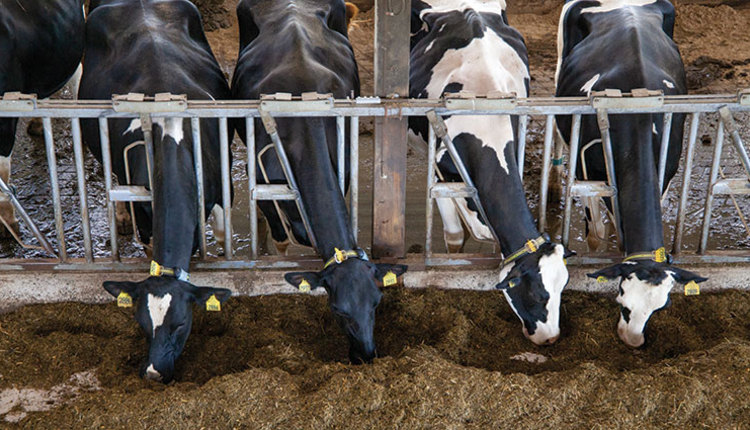Higher forage rations deserve a look |
| By Larry Chase |
|
|
The author is an emeritus dairy nutrition professor in the Department of Animal Science at Cornell University. 
Dairy cattle and other ruminants are biologically designed to convert forages and other fibrous feeds into high-quality milk and meat for human consumption. The rumen microorganisms are the key to making this system work. Forages are the foundation upon which nutritionally sound economical and rumen healthy rations are built. The quality and quantity of forages fed to the dairy herd is directly related to milk production, purchased feed cost, whole-farm nutrient balance, and profitability. In 2017, we did a survey of feed industry professionals to obtain input on forage feeding in dairy herds. One question was how the amount of forage in the ration had changed in the last 10 to 15 years. They reported that 91% of the herds had raised forage feeding levels. Herds feeding over 60% of the total ration dry matter as forages represented 36% of the responses while herds feeding over 70% forage accounted for 11% of the herds. In 2019, we surveyed 79 herds with an average energy-corrected milk production of 109 pounds of milk. Nineteen of these herds fed over 60% forage in the ration with one herd feeding 72% forage. Why have forage feeding levels increased over the years? One reason is the improvements made in forage quality and yield of the corn hybrids and forage varieties in the market. There have also been advances in forage production, management, and storage practices. The result is that farms are producing more tons of high-quality, more digestible forage per acre. This adds to the inventory of forage available to use in feeding programs. Advances in forage analysis, ration formulation programs, and feeding management practices provide better information to utilize forages in rations. All of these contribute to the enhanced forage levels in rations. The two primary reasons listed for not feeding higher levels of forage were forage quality not being good enough and inadequate forage inventory. What are the benefits of feeding higher forage rations? One is the opportunity to lower purchased feed costs and improve income over feed cost. Other benefits from our survey include improved milk components, improved animal health, lower culling rate, and cows staying in the herd longer. What does your forage customer want to eat? The dairy cow is your forage customer. Cows are looking for a consistent supply of high-quality, high fiber digestibility, and palatable forage. If silage is fed, it needs to be well fermented. There also needs to be an adequate amount of “effective” physical fiber to support chewing, rumination, and rumen health. What do these rations look like? A recent example was from a farm with a high group producing an average of 115 pounds of milk per day. The ration fed was 69% forage with 16.6% crude protein (CP), 31% neutral detergent fiber (NDF), 25% forage NDF, 27% starch, and 5.3% fat. Forages fed were brown midrib (BMR) corn silage and alfalfa silage in a 2-to-1 ratio on a dry matter basis. A second herd was producing 85 pounds of milk with a ration containing 83% forage that included a mix of corn silage (55% of forage), mixed legume-grass silage (37%), and oatlage 8%). There are other herds feeding a wide variety of forages in higher forage rations. Forage quality and consistency are more important than forage type. How do you successfully implement a higher forage feeding program for your herd? The key points involved in this process are: Mindset: Both the dairy producer and nutritionist need to buy in to this concept to make it work in a herd. The risk of failure is high without the proper mindset. Consistent quality forages: As you feed more forage, less grain is being fed to adjust for changes in forage quality. Any variation in forage quality will have a larger impact on milk production in herds feeding higher forage rations. Forage inventory: It may take 15% to 30% more forage to feed the same number of cows. Make sure you have an adequate forage supply before starting to feed more forage. Do frequent inventory updates to assure the supply will last until the next harvest. Forage storage and allocation: Have the ability to store forages by quality so that you can allocate specific quality forages to the appropriate animal groups. Forage analysis: More frequent analysis is needed to keep the feeding program on target. Include NDF digestibility in the analysis package. Ration formulation: Rations need to be checked more frequently using forage analysis data to keep the program on target. Rations may need to be adjusted more often for changes in forage dry matter. On-farm dry matter determinations should be used. Feeding management: Cows will need more time to eat and may need more bunk space. You might need to feed more frequently or push feed up more often to keep it fresh and available to the cow. Is your TMR mixer large enough? Higher forage rations are bulkier, and this may change the number of mixes made each day. Watch the cows: Keep tabs on dry matter intake, milk production, milk components, chewing and rumination, and manure consistency. This is especially important when making changes in the level of forage in the ration. Be patient. It takes cows time to adjust to higher forage rations. Feeding higher forage rations is an opportunity that should be considered in many dairy herds. These rations take advantage of the biology of the cow and have potential to improve profitability. Forage quality and consistency are the keys to making this work. Higher forage rations don’t work with variable and inconsistent forages. This article appeared in the March 2020 issue of Hay & Forage Grower on pages 10 and 11. Not a subscriber? Click to get the print magazine. |
